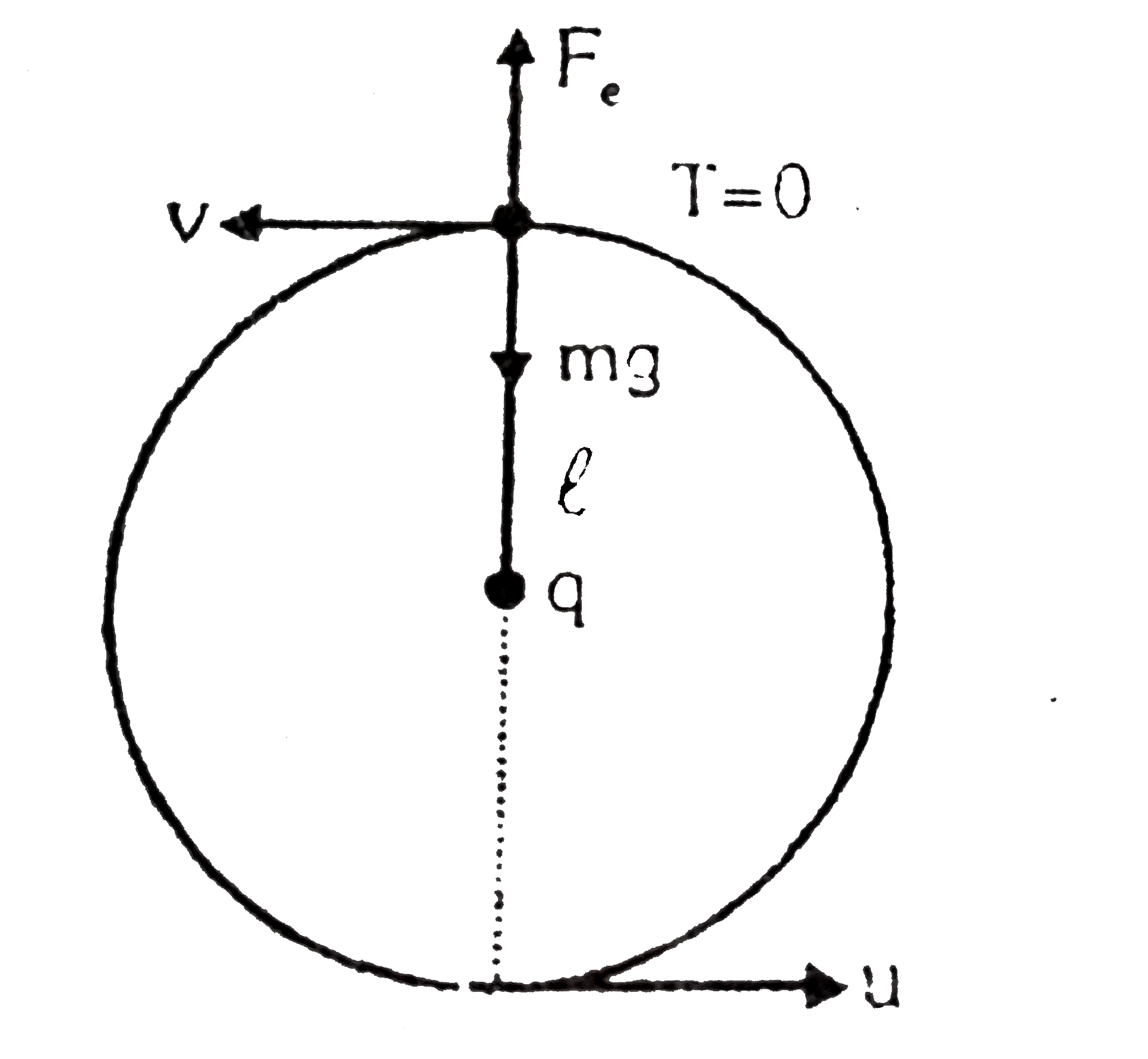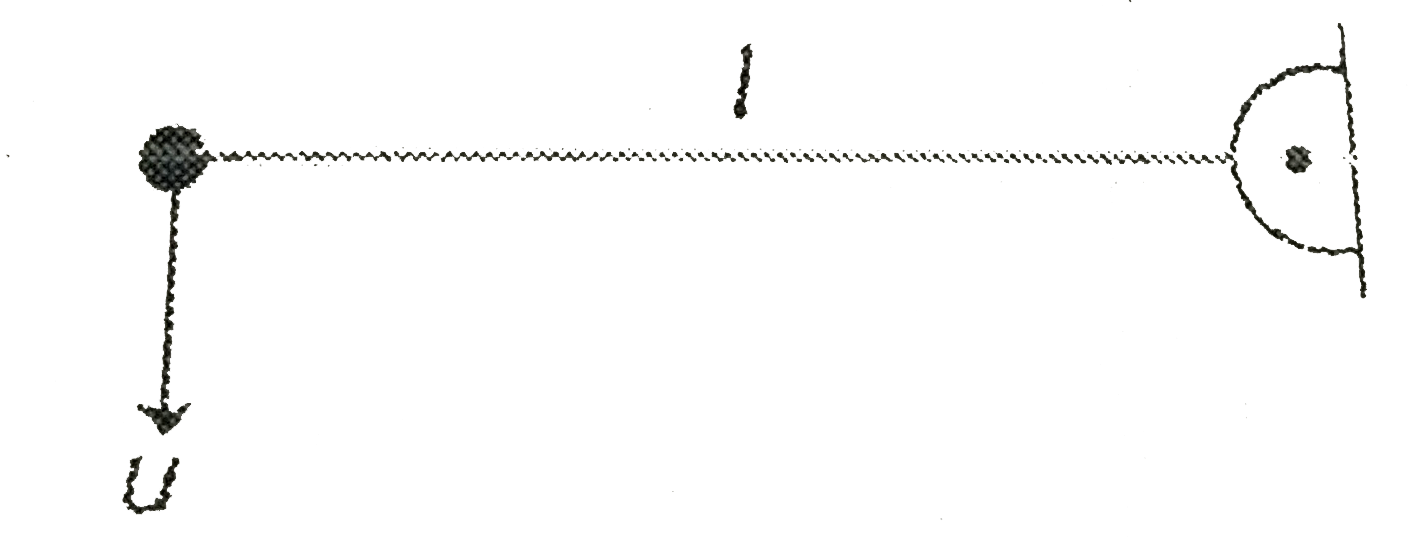A small ball if mass 2×10−3Kg having a charges of 1μC is suspended by a string of length 0.8m Another identical ball having the same charge is kept at the point of suspension . Determine the minimum horizontal velocity which should be imparted to the lower ball so that it can make complete revolution .
The correct Answer is:5.86m/s
Given : q=1μC=10−6C

m=2×10−3 kg and l=0.8m
Let u be the speed of the particle at its lowest point and v its speed at high point. At highest point three forces are acting on the particle.
(i) Electrostatic repulsion
Fe−14πε0=q2l2 (outwards)
(ii) Weight W=mg (inwards)
(iii) Tension T (inwards)
T=0, if the particle has just to complate the circle and the necessary centripetal force provided by
W−Fe i.e., mv2l=W−Fe
⇒v2=lm(mg−14πε0×q2l2)
v2=0.82×103⎛⎝2×103×10−9.0×109×(10−6)2(0.8)2⎞⎠
⇒v2=2.4m2/s2 ...(i)
Now, the electrostatic potential energy at the lowest and highest points are equal. Hence, from conservation of mechanical energy.
Increase in gravitational potential energy
= Decrease in kinetic energy
⇒mg(2l)=12m(u2−v2)⇒u2−v2=4gl
Substituting the values of v2 from Eq (i), we get
u2=2.4+4(10)(0.8)=34.4m2/s2
∴u=5.86m/s
Therefore minimum horizontal velocity imparted to the lower ball, so that it can make complete revolution, is 5.86m/s
Topper's Solved these Questions
- BOOK - ALLENCHAPTER - MISCELLANEOUSEXERCISE - LINKED COMPREHENSION TYPE3videos
MISCELLANEOUS
- BOOK - ALLENCHAPTER - KINEMATICS (MOTION ALONG A STRAIGHT LINE AND MOTION IN A PLANE)EXERCISE - BEGINNER S BOX-78videos
KINEMATICS (MOTION ALONG A STRAIGHT LINE AND MOTION IN A PLANE)
- BOOK - ALLENCHAPTER - PHYSICAL WORLD, UNITS AND DIMENSIONS & ERRORS IN MEASUREMENT EXERCISE - EXERCISE-IV8videos
PHYSICAL WORLD, UNITS AND DIMENSIONS & ERRORS IN MEASUREMENT
Similar Questions
A small ball of mass 2×10−3kg, having a charge 1μC, is suspended by a string of length 0.8m. Another identical ball having the same charge is kept at the point of suspension. Determine the minimum horizontal velocity that should be imparted to the lower ball so that it can make a complete revolution.
View SolutionA small ball of mass m having charge q is suspended by a string of length L. Another identical ball having the same charge is kept at the point of suspension. Determine the minimum horizontal velocity which should be imparted to ball at lowest point so that it can make complete revolution.
View Solution
Knowledge Check
- Question 1 - Select One
A ball of mass m is attached to one end of a light rod of length l, the other end of which is hinged. What minimum velocity v should be imparted to the ball downwards, so that it can complete the circle ?
 A√glB√5glC√3glD√2gl
A√glB√5glC√3glD√2gl - Question 2 - Select One
The bob of a pendulum has mass m=1kg and charge q=40μC. Length of the pendulum is l=0.9m. The point of suspension also has the same charge 40μC. What the minimum speed u should be imparted to the bob so that it can complete verticel circel ?
 A6ms−1B2ms−1C8ms−1D4ms−1
A6ms−1B2ms−1C8ms−1D4ms−1 - Question 3 - Select One
The bob of a simple prendulum is suspended by a strinng of length 80 cm . What minimum horizontal velocity should be imparted to the bob so that it reaches it reaches the height of suspension point ? (g=10m/s2)
A3m/sB4m/sC2m/sD5m/s
A small ball having charge +q and mass m is suspended at one end of a light string of length and can rotate in vertical plane.A uniform electric field E exists in the region in vertically upward direction (mg>qE) .The minimum velocity required to be imparted to the ball at the lowest position in order to successfully negotiate the circular loop is √x(g−qEmy) then find x+y .x&y are lowest possible integer.
View SolutionA small positively charged ball of mass m is suspended by an insulating thread of length L. This ball remains in equilibrium with string horizontal when another small charged ball is placed exactly at a distance L below the point of suspension of the first ball. The second ball is slowly moved away from the first ball to a far away point. (The second ball is moved horizontally so that the first ball does not accelerate). As a result the first ball lowers down to the original position of the second ball and the string become vertical. Find the work done by the external agent in removing the second ball.
 View Solution
View SolutionA "0.50gm" ball carries a charge of magnitude 10 μ C" It is suspended by a string in a downward electric field of intensity "300N/C" .If the charge on the ball is positive,then the tension in the string is g=10ms−2
View SolutionA ball of mass m is suspended by a thread of length l. With what minimum velocity has the point of suspension to be shifted in the horizontal direction for the ball to move along the circle about that point? What will be the tension of the thread at the moment it will be passing the horizontal position?
View SolutionA pith-ball A of mass 9×10−5 kg carries a charge of 5μC. What must be the magnitude and sign of the charge on a pith-ball B held 2 cm directly above the pith-ball A, such that the pith-ball A remains stationary ?
View Solution
